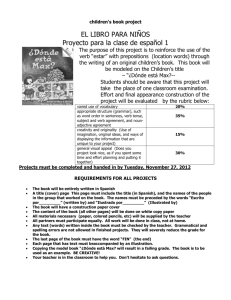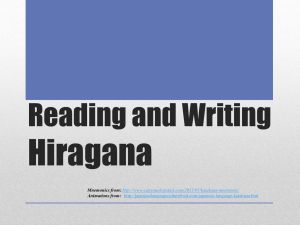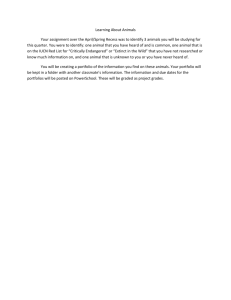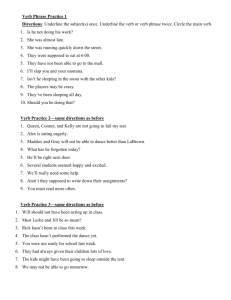Wordy version
advertisement
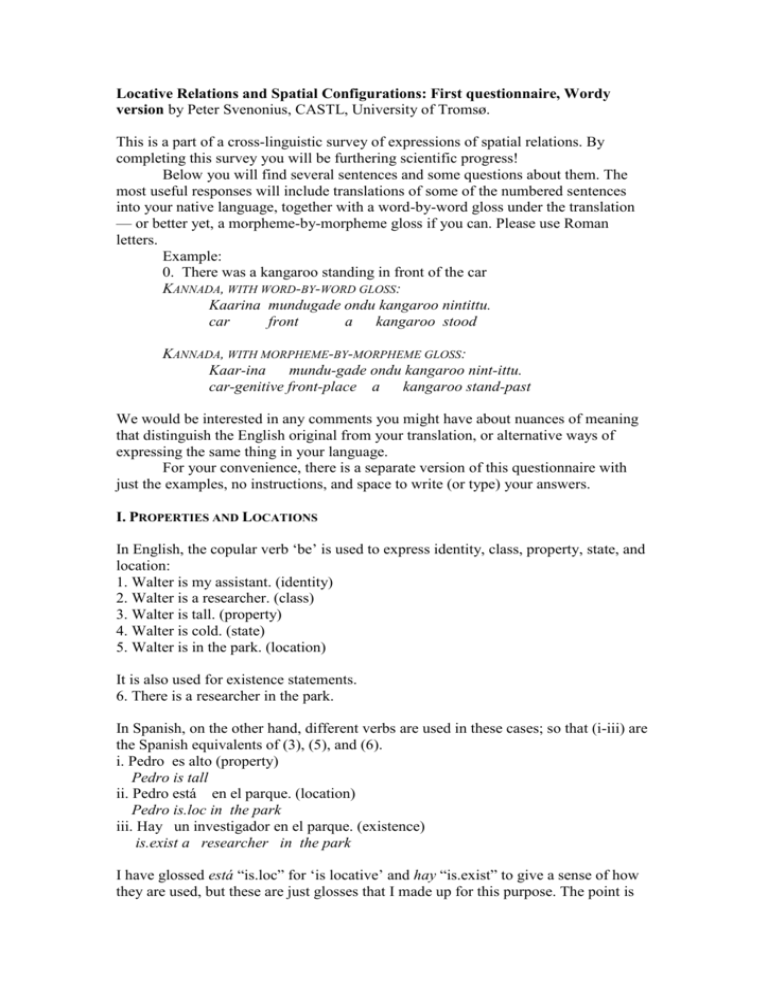
Locative Relations and Spatial Configurations: First questionnaire, Wordy version by Peter Svenonius, CASTL, University of Tromsø. This is a part of a cross-linguistic survey of expressions of spatial relations. By completing this survey you will be furthering scientific progress! Below you will find several sentences and some questions about them. The most useful responses will include translations of some of the numbered sentences into your native language, together with a word-by-word gloss under the translation — or better yet, a morpheme-by-morpheme gloss if you can. Please use Roman letters. Example: 0. There was a kangaroo standing in front of the car KANNADA, WITH WORD-BY-WORD GLOSS: Kaarina mundugade ondu kangaroo nintittu. car front a kangaroo stood KANNADA, WITH MORPHEME-BY-MORPHEME GLOSS: Kaar-ina mundu-gade ondu kangaroo nint-ittu. car-genitive front-place a kangaroo stand-past We would be interested in any comments you might have about nuances of meaning that distinguish the English original from your translation, or alternative ways of expressing the same thing in your language. For your convenience, there is a separate version of this questionnaire with just the examples, no instructions, and space to write (or type) your answers. I. PROPERTIES AND LOCATIONS In English, the copular verb ‘be’ is used to express identity, class, property, state, and location: 1. Walter is my assistant. (identity) 2. Walter is a researcher. (class) 3. Walter is tall. (property) 4. Walter is cold. (state) 5. Walter is in the park. (location) It is also used for existence statements. 6. There is a researcher in the park. In Spanish, on the other hand, different verbs are used in these cases; so that (i-iii) are the Spanish equivalents of (3), (5), and (6). i. Pedro es alto (property) Pedro is tall ii. Pedro está en el parque. (location) Pedro is.loc in the park iii. Hay un investigador en el parque. (existence) is.exist a researcher in the park I have glossed está “is.loc” for ‘is locative’ and hay “is.exist” to give a sense of how they are used, but these are just glosses that I made up for this purpose. The point is that they are different verbs, and está is not a form of es the way is and are are different forms of the same verb, be. Q1.1: In your language, is it most natural to use the same verb or different ones, in these different situations? Provide some examples. II. POSTURES English furthermore uses ‘be’ to locate all sorts of items. 7. The broom is in the corner. 8. The bottle is on the table. 9. John is on the couch. 10. The newspaper is on the couch. A language like Norwegian, on the other hand, requires one to use verbs which are more specific about the posture of the item being located, so that (iv-vi) are the Norwegian equivalents of (7), (9), and (10). iv. Kost-en står i hjørn-et. broom-the stands in corner-the v. Jon sitter i sofa-en. Jon sits in couch-the vi. Avis-en ligger på sofa-en. newspaper-the lies on couch-the Some languages use the verb to differentiate the location of messy things like noodles, small round things like figs, and compact solid things like cups. English doesn’t, so the same verb ‘be’ is used for all of the following: 11. The cup is on the shelf. 12. The noodles are in the bowl. 13. The figs are in the bowl. 14. The tablecloth is on the table. The Mayan language Mam, on the other hand, has a great variety of what are called ‘positionals,’ for example the following: i. b’onk ii. renky iii. lank iv. chank v. tzank vi. tz’ank ‘standing or sitting, a fat person’ ‘standing or sitting, a person with fat legs’ ‘standing or sitting, a person without shoes’ ‘thrown down, a spool or a leafless branch’ ‘thrown down, a lightweight substance’ ‘thrown down, a round or spherical object’ Q1.2: Does your language make any distinctions of this kind? Please give some examples. Feel free to make up your own sentences if they better illustrate the different posture or position verbs. For comparison, please also provide some corresponding existence statements, such as the following: 15. There is a broom in the corner. 16. There is a bottle on the table. 17. There is a man on the couch. 18. There is a newspaper on the couch. 19. There is a cup on the shelf. 20. There are noodles in the bowl. 21. There are figs in the bowl. 22. There is a tablecloth on the table. III. CONTACT, SUPPORT, CONTAINMENT Now I am going to focus on the spatial configuration between the thing being located and the place it is located in, at, on, or by. In English, it seems that a basic opposition is made among places conceived of as points, those conceived of as surfaces, and those conceived of as containers. You locate something at a point, on a surface, or in a container. This is illustrated by the following: 23. The postman is at the door. 24. The cup is on the table. 25. The key is in the drawer. Different languages make different divisions. For English, the following examples all basically involve surfaces, so they all use on. 26. The picture is on the wall. 27. The plaster is on my knee. 28. The ring is on my finger. In Dutch, however, these are all different: the picture hangs aan the wall, the plaster (to cover a cut) is op your knee, and the ring is om your finger. Other languages make additional distinctions, for example in examples like the following: 29. The apple is on the skewer. 30. The carpet is on the floor. 31. The tiger is in the jungle. 32. The apples are on the branch. Some languages express a difference between something fitting loosely and something fitting tightly, in a way that English doesn’t. Other languages use different expressions for being by a person and being by a non-human thing. Q1.3: How are basic arrangements of two objects expressed in your language? Please provide examples. For comparison, please give a few corresponding existence statements as well: 33. There is a cup on the table. 34. There is a plaster on my knee. 35. There is an apple on the skewer.
